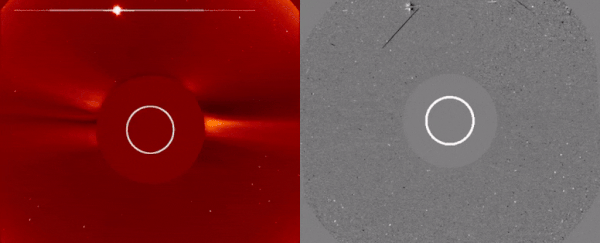Between its raging heat and intense gravity, the region really close to the Sun is a pretty hazardous place. And that has been spectacularly demonstrated in a new video of a comet, like the legendary Icarus, falling to its doom when it veered a little too close.
The comet's death dive was captured by the Solar and Heliospheric Observatory (SOHO) spacecraft on August 15, the video clearly showing a glowing streak heading straight for the Sun and disappearing as it dies.
The bright spot in the upper left is Venus. The circle in the middle is an occulting disc, used to block out the bright light of the Sun so that things around it can be seen more clearly.
Of course I was on a 3-day vacation when this stunning Kreutz sungrazing comet zoomed through the LASCO cameras. Sadly, its fate was the same as 99% of sungrazers: total vaporization.
— Karl Battams (@SungrazerComets) August 17, 2019
(📸: @ESA/@NASASun/@USNRL SOHO/LASCO C2, https://t.co/pGnh6KYAXw) pic.twitter.com/mqlaxEj3YX
The object is of a type known as a sungrazer comet, which zoom around the Sun in swarms. And although we don't often see them disintegrate so gloriously in the Sun's atmosphere, they're actually fairly common - part of the death process of what would have been a larger comet, long ago.
"What you're seeing is the end of a cascade of fragmentation and disintegration, where you once had a much bigger comet, that was just one comet that came too close to the Sun," astronomer Jonti Horner of the University of Southern Queensland told ScienceAlert.
That close approach would have played havoc on the original comet, as heat stress and tidal (gravitational) stress from the Sun's influence pulled it apart into smaller pieces. Then, the pieces would have separated into slightly different orbital periods, while maintaining similar orbital paths.
When the fragments came round again, the same thing would happen, and they would break into ever-smaller comet bits. Some comet pieces expire on the spot, while others continue on their journey, around and back again.
"You gradually get more and more smaller and smaller objects following the same kind of orbit, until you have this continual flood of objects falling into the Sun… and some of them making it through intact and going on to be the parents of the next generation coming in one orbit later," Horner said.
This particular comet belonged to the biggest such family, fragmented from a comet that broke up centuries ago. It was the German astronomer Heinrich Kreutz who demonstrated that this particular group was related, hence they are named Kreutz sungrazers.
The Kreutz family orbits out as far as 170 times the distance between Earth and the Sun, before looping in within a few hundred thousand kilometres of the Sun. (Other families include the Marsden and Kracht sungrazers, originating from two other comets.)
We've known about sungrazers for some time. Some, like 1965's Comet Ikeya-Seki, are so large, they are visible even in daylight when they draw close to the Sun. But we weren't aware of exactly how many sungrazers are out there until SOHO was launched into space in 1995.
"With the launch of SOHO, suddenly, hundreds and thousands of sungrazers have been seen, because SOHO can spot the tiny little ones that we can't see from the surface of the earth with ground based instrumentation," Horner explained.
"That means from there just being a few tens of comets known over the last few hundred years, we now know several thousand of them."
And most sungrazers - around 99 percent - fail to survive.
Another comet (a Kreutz sungrazer) was destroyed. pic.twitter.com/xmx9vJTk9n
— Halo CME (@halocme) August 16, 2019
Comet fragments don't slam into the Sun. That would be pretty awesome, but they simply can't come close enough to the Sun to impact, as instead they're disintegrated by the intense heat long before that point. If you watch the video carefully, you can see it - the long bright tail crumbling into dust.
Astronomers will be studying that streak to learn more about the comet. Its size, for instance, can add to our understanding of how large or small a fragment has to be to survive an orbit around the Sun.
We know this chunk was relatively large - that's why it's so visible. But what we don't know is which swarm it belongs to. Horner noted that there's some speculation that a new swarm is predicted to start coming through - which could indicate a much larger comet chunk is on the way sometime in the next decade.
"It will be really interesting if this was the first bit of that new clump coming through, or a member of the new clump, rather than an older clump that's trailing away," he told ScienceAlert.
"What would be awesome, something I'd be really happy to get to see in my lifetime, is a really spectacular sungrazer. Part of me just goes, 'this one's a little bit brighter, maybe there's some more coming along a little bit better still.' I'm just keeping my fingers crossed."
